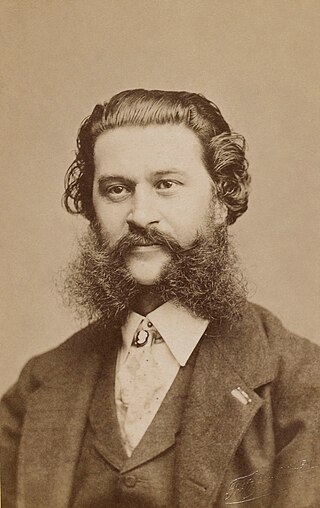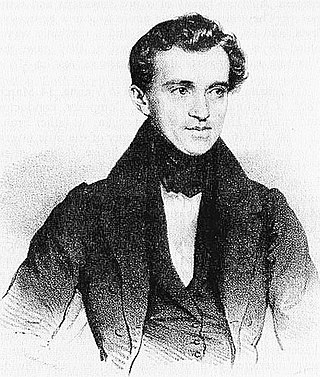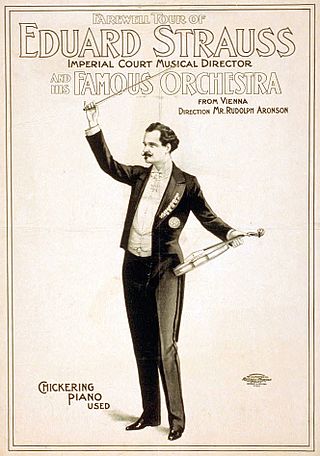
Johann Baptist Strauss II, also known as Johann Strauss Jr., the Younger or the Son, was an Austrian composer of light music, particularly dance music and operettas as well as a violinist. He composed over 500 waltzes, polkas, quadrilles, and other types of dance music, as well as several operettas and a ballet. In his lifetime, he was known as "The Waltz King", and was largely responsible for the popularity of the waltz in Vienna during the 19th century. Some of Johann Strauss's most famous works include "The Blue Danube", "Kaiser-Walzer", "Tales from the Vienna Woods", "Frühlingsstimmen", and the "Tritsch-Tratsch-Polka". Among his operettas, Die Fledermaus and Der Zigeunerbaron are the best known.

Johann Baptist Strauss I, also known as Johann Strauss Sr., the Elder or the Father, was an Austrian composer of the Romantic Period. He was famous for his light music, namely waltzes, polkas, and galops, which he popularized alongside Joseph Lanner, thereby setting the foundations for his sons—Johann, Josef and Eduard—to carry on his musical dynasty. He is best known for his composition of the Radetzky March.

Josef Strauss was an Austrian composer.

Eduard "Edi" Strauss was an Austrian composer who, together with his brothers Johann Strauss II and Josef Strauss made up the Strauss musical dynasty. He was the son of Johann Strauss I and Maria Anna Streim. The family dominated the Viennese light music world for decades, creating many waltzes and polkas for many Austrian nobility as well as dance-music enthusiasts around Europe. He was affectionately known in his family as 'Edi'.

The Kuss-Walzer, Op. 400 is a waltz by Johann Strauss II composed in 1881. The waltz was originally dedicated to his second wife, Angelika Dittrich (1850–1919), but Strauss withdrew that dedication after their divorce in 1882. The waltz comprises melodies from Strauss' popular operetta Der lustige Krieg and is an orchestral treatment of the act 2 aria "Nur für Natur" which was a hit when first performed. Eduard Strauss, the composer's brother, first conducted the orchestral piece at the Court Ball in Vienna in 1882.
Wiener Frauen or 'Viennese Ladies' op. 423 is a waltz composed by Johann Strauss II in 1886.
Kaiser-Jubiläum Jubelwalzer is a waltz composed by Johann Strauss II in 1888 to commemorate the fortieth anniversary of the accession to throne of his monarch, Emperor Franz Josef. The Emperor commissioned the waltz in order to celebrate the progress of Vienna and the prosperity of the Austro-Hungarian Monarchy.
"Die Publicisten" is a waltz by Johann Strauss II composed in 1868. It was written for the sixth Concordia Ball held in the Sofienbad-Saal on the 4 February of the same year. The waltz's title was an allusion to Vienna's press, with whom he maintained a fruitful partnership that his family had enjoyed since the days of his father Johann Strauss I. The more or less symbiotic association was needed as the musical business of composers would inevitably flourish under favorable press reviews and the establishment of the Vienna Journalists' and Authors' Association in 1859 would signify an even more closer relationship between both composer and the press. The Concordia Ball named after the Roman God of civic concord had its first ball in 1863.

Rathausball-Tänze op. 438 is a waltz by composer Johann Strauss II written in 1890 in honour of the inauguration of the new city hall of Vienna. At the opening of the new banqueting hall (Festsaal) on 12 February 1890 two rival orchestras were commissioned to provide dance music for the occasion; the Strauss Orchestra under the direction of Eduard Strauss, and that of rival Kapellmeister Karl Michael Ziehrer who was head of the Vienna House Regiment 'Hoch und Deutschmeister No. 4'.
Liebeslieder op. 114 is a waltz by Johann Strauss II written in 1852. At the time it was conceived, the waltz was titled 'Liebesgedichte' or "Love Poems" and during its first performance, it was even announced as 'Liebesständchen' or "Love Serenade". The first performance was at the famed Vienna Volksgarten on 18 June 1852 under the composer's direction.
Künstlerleben, Op. 316 is a waltz written by Johann Strauss II in 1867, following closely on the success of the popular "The Blue Danube". Austria was severely shaken the previous year 1866 by the crushing defeat that the Austrian army suffered in the Battle of Königgrätz and many of the year's festivities and balls were cancelled as the prevalent depressing mood affected most of Vienna's populace.
Feenmärchen (Fairy-tales) waltz op. 312 is composed by Johann Strauss II in 1866. The same year had witnessed the glaring military weakness of the ailing Habsburg dynasty after a bitter defeat to the hands of the Prussian army at the fateful Battle of Königgrätz. Almost immediately, various Vienna's establishments usually packed with music-lovers dancing the night away took the news with foreboding and many of the year's festivities were cancelled or with-held.
Bürgersinn op. 295 is a waltz by Johann Strauss II composed in 1865 for the Citizen's Ball held during the Vienna Carnival Fasching of the year. His prestigious post of the 'KK Hofballmusikdirektor', which he attained in 1863, meant that his responsibilities included composing dance music for these functions.

Wiener Blut Op. 354 is a waltz by Johann Strauss II first performed by the composer on 22 April 1873. The new dedication waltz was to celebrate the wedding of the Emperor Franz Joseph I's daughter Archduchess Gisela Louise Maria and Prince Leopold of Bavaria. However, the waltz was also chiefly noted by Strauss' biographers as the début of Strauss with the Vienna Philharmonic Orchestra where for many years, the Philharmonic had dismissed any association with the 'Waltz King' as it had not wished to be associated with mere 'light' or 'pops' music. The festival ball celebrating the event was held at the Musikverein Hall which is the venue for the present day Neujahrskonzert.
Neu Wien , opus 342, is a waltz written by Johann Strauss II in 1870 and dedicated to Nicolaus Dumba (1830-1900), who was a fervent patron of Arts and was the Chairman of the Wiener Männergesang-Verein and Vice-President of the Gesellschaft der Musikfreunde in Wien.
Flugschriften ('Pamphlets') op. 300 is a waltz by Johann Strauss II written in 1865 and first performed on 17 January 1866 at the Habsburg Court Ball in the Rittersaal of the Imperial Hofburg Palace graced by the Emperor Franz Josef and Empress Elisabeth. The waltz had earlier been intended to be dedicated for the occasion of the annual ball of the Vienna Authors' and Journalists' Association 'Concordia' ball held at the Sofienbad-saal ballroom on 21 January 1866.
Studentenlust op. 285 is a waltz by Johann Strauss II composed in 1864. The waltz was written as a dedication piece for the Students' Ball held in the Redoutensaal of the Imperial Hofburg Palace on 31 January of that year.

Wiener Blut is an 1899 operetta named after Johann Strauss II's eponymous 1873 waltz. It was made with Strauss' approval, but without his participation. Its score reuses music he wrote for other works along with some music by his brother Josef Strauss; the job of compilation went to Adolf Müller. Its libretto is by Victor Léon and Leo Stein. The setting is the Congress of Vienna. Strauss may have seen a draft of the work, but he died a few months before its 26 October premiere at Vienna's Carltheater.
Leitartikel op. 273 is a waltz composed by Johann Strauss II in 1863 and first performed at the Vienna's Artists and Journalists' Association ball called 'Concordia', which glorifies the Roman goddess of civic harmony, on 19 January 1863. Theoretically, this work would have been Strauss' only contribution towards the festivity of Vienna's Fasching of that year as his health did not permit laborious hours of conducting nor of composing.
Farewell to America is the name of a waltz composed by Johann Strauss II. In the immediate wake of the composer's visit to the United States in the summer of 1872, when he conducted several times in Boston and New York, no less than seven publishers issued waltzes supposedly composed by Strauss. Only two from the total of nine compositions that were published are known to have been performed by Strauss during his tour of the United States: the Jubilee Waltz and the Manhattan Waltzes. It is unknown whether or not the other compositions that were published were written by Strauss while he was in America, completed by him after his return to Vienna and sent through the mail, or that some of the publications had nothing to do with Strauss himself, but were compiled by publishers anxious to benefit from Strauss' American tour and the clamour for new Strauss music.











